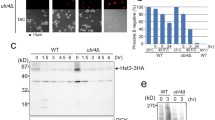Summary
An electron microscopical investigation of synchronously dividing yeast cells (S. cerevisiae) prepared by freeze-etching revealed that ER is inducing bud formation. In the first step, ER elements join and form a nearly-closed bag-like envelope which surrounds the nucleus and vacuoles. From the small opening of the ER-envelope, vesicles are produced by a splitting or proliferation of the ER-membranes. The vesicles fuse with the plasmalemma and release their content into the cell wall. In this limited area, bud formation starts explosively by a local evagination of the cell wall. The ER-derived vesicles are concluded to contain proteindisulfide-reductase. The limited introduction of the enzyme into the cell wall explains bud formation to be initiated by a local increase of wall plasticity caused by the reduction of disulfide bonds between cell wall proteins. The wall is forced to extrude by the internal pressure (turgor) of the cell.
Similar content being viewed by others
References
Bonner, J.: Zum Mechanismus der Zellstreckung auf Grund der Mizellarlehre. Jb. wiss. Bot. 82, 377–412 (1936).
Brown, C. M., and J. S. Hough: Protein-disulfide-reduction in yeast. Nature (Lond.) 211, 201 (1966).
Heyn, A. N. J.: Der Mechanismus der Zellstreckung. Diss., Utrecht (1931).
Kessler, G., and W. J. Nickerson: Glucomannan-protein complexes from cell walls of yeast. J. biol. Chem. 234, 2281–2285 (1959).
Lamport, D. T. A.: The protein component of primary cell walls. pp. 151–218. In R. D. Preston (ed.): Advances in Botanical Research, vol. 2. New York: Academic Press 1965.
Matile, P.: Intracelluläre Lokalisation proteolytischer Enzyme von Neurospora crassa. I. Mitteilung. Z. Zellforsch. 65, 884–896 (1965).
—, M. Jost, and H. Moor: Intracelluläre Lokalisation proteolytischer Enzyme von Neurospora crassa. II. Mitteilung. Z. Zellforsch. 68, 205–216 (1965).
Moor, H.: Die Gefrierfixation lebender Zellen und ihre Anwendung in der Elektronenmikroskopie. Z. Zellforsch. 62, 546–580 (1964).
Moor, H.: Freeze-etching. High vacuum report, no 2. Ed. Balzers AG, Balzers, Lichtenstein (1965).
Moor, H.: The performance of freeze-etching and the interpretation of results concerning the surface structure of membranes and the fine structure of microtubules and spindel fibres. High vacuum report, no 9. Ed. Balzers AG, Balzers, Liechtenstein (1966).
Moor, H.: Feinbau der Mikrotubuli in Hefe nach Gefrierätzung. Protoplasma (Wien) (in press) (1967).
Moor, H., and K. Mühlethaler: Fine structure in frozen-etched yeast cells. J. Cell Biol. 17, 609–628 (1963).
——, H. Waldner, and A. Frey-Wyssling: A new freezing ultramicrotome. J. Biochem. Cytol. 10, 1–13 (1961).
Nickerson, W. J.: Molecular basis of form in yeast. Bact. Rev. 27, 305–324 (1963).
—, and G. Falcone: Identification of proteindisulphide-reductase as a cellular division enzyme in yeast. Science 124, 722 (1950).
Went, F. W.: Wuchsstoff und Wachstum. Diss., Utrecht 1927.
Author information
Authors and Affiliations
Rights and permissions
About this article
Cite this article
Moor, H. Endoplasmic reticulum as the initiator of bud formation in yeast (S. cerevisiae) . Archiv. Mikrobiol. 57, 135–146 (1967). https://doi.org/10.1007/BF00408697
Received:
Issue Date:
DOI: https://doi.org/10.1007/BF00408697




